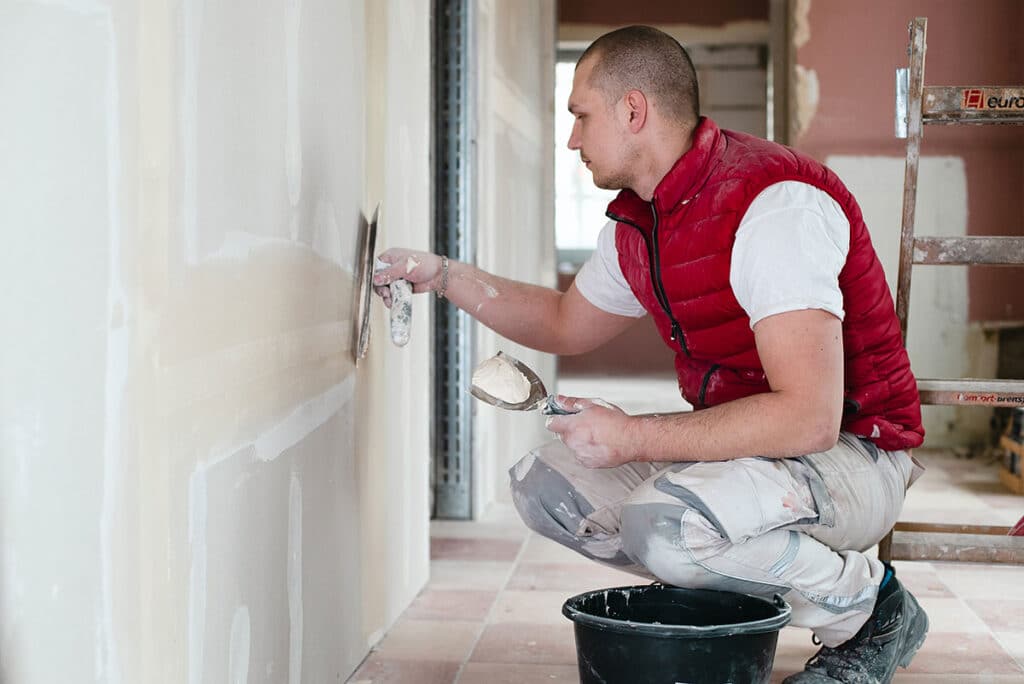Just go for it: DIY levelling work with health-friendly products
In the construction of new builds but above all in building renovation, hardly any trade can do without filling or levelling products. The smooth compounds can also be used for decorative purposes. They are available either ready to use in tubes or as a powder for mixing. To protect the health of both product users and residents, it is important to use products that feature the lowest possible emissions.
Levelling compounds are used all around the house – inside and outside. Professional craftsmen appreciate their versatile use, for example when fixing thermal insulation composite systems (ETICS) to exterior walls, or for interior finishing work when installing plasterboards or gypsum fiberboards. For do-it-yourselfers, fillers or levellers are an indispensable helper, especially when carrying out minor touch-up work or even major repairs. Whether for filling drill holes or stress cracks in the floor, for patching up plaster damage on walls and ceilings, or for repairing defective joints and uneven floor areas: there is always something that needs filling or smoothing in the house.
Important to know for DIY enthusiasts, a matter of course for professional craftsmen: Do not forget the necessary preparatory work before applying a filler or leveller. Drill holes should always be cleaned, for example by blowing or scraping them out. It is also advisable to moisten and/or prime the substrate before applying the filler/leveller. After that, the compound can be applied and smoothed down. If the compound shrinks during the drying process, it is best to apply another layer. If necessary, it may be advisable to finish the surface with sandpaper to achieve a particularly fine texture.
Levelling compounds can also be used to produce decoratively designed walls. This special application is usually known as Venetian plaster finish. Spectacular effects can be achieved with the help of levellers and colors, supplemented by accessories such as different types of spatulas and trowels to produce the desired effect. Marbled wall surfaces in bold colors are quite popular these days. Other fancy designs that can be created with the help of levelling compounds imitate the look of concrete or wood. For less experienced DIYers, some manufacturers offer trial sets that allow you to test your skills in a side room.
Regardless of whether a craftsman or a DIY enthusiast carries out the filling and levelling work on walls, floors and ceilings: all users should be particularly careful to choose the right product. For the benefit of health and safety at work and at home, it is recommended to use fillers/levellers that do not contain solvents or plasticizers, as this reduces product emissions to a minimum. This also applies to other materials required for the work such as adhesives, primers and paints. Products carrying the EMICODE® label of the GEV, the German Association for the Control of Emissions in Products for Flooring Installation, Adhesives and Building Materials, undergo strict quality tests that guarantee product users and consumers the lowest possible emissions. This also includes volatile organic compounds (VOCs), which are harmful to human health. Important information: Manufacturers must have their products regularly tested by independent institutes in the form of unannounced spot checks. They are not allowed to advertise their products with EMICODE® EC1 labels that they acquired years ago.
If the above recommendations are followed, there is nothing to stop you from doing your own filling and levelling work. True to the motto: Just go for it!

Photo: ©GEV/Iris Pohl
When doing interior finishing work and installing plasterboards or gypsum fiberboards, the joints between the boards must be expertly filled to provide a smooth surface.
Do You Have Questions?
If you have any questions on certain topics or want to contact us for another reason, please contact us by phone, fax or email.
Phone: +49 211 / 67931-20
Fax: +49 211 / 67931-33
info@emicode.com
Share article on Social Media:
